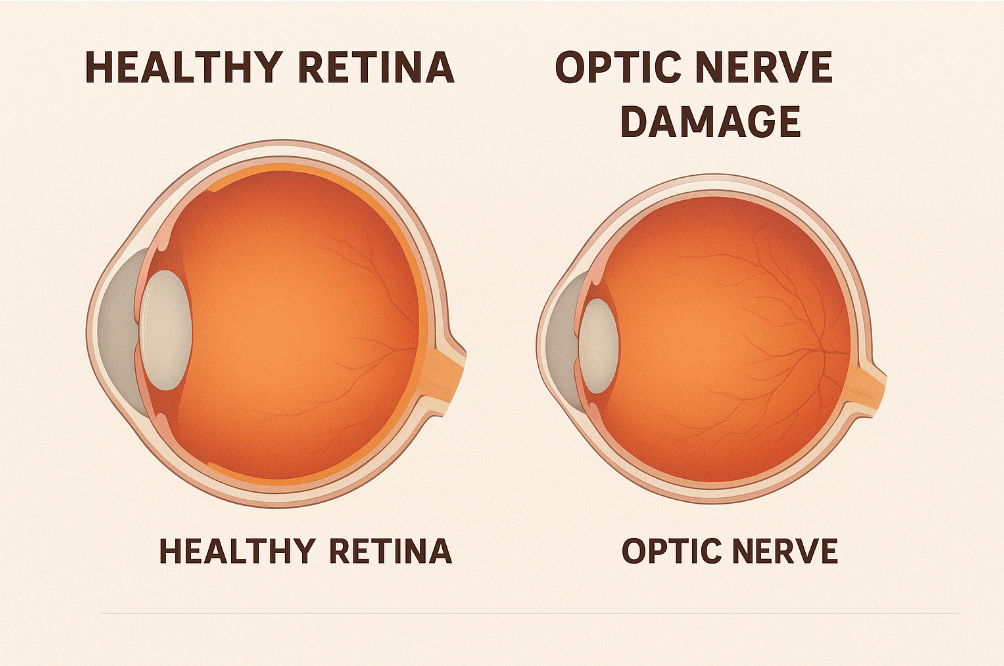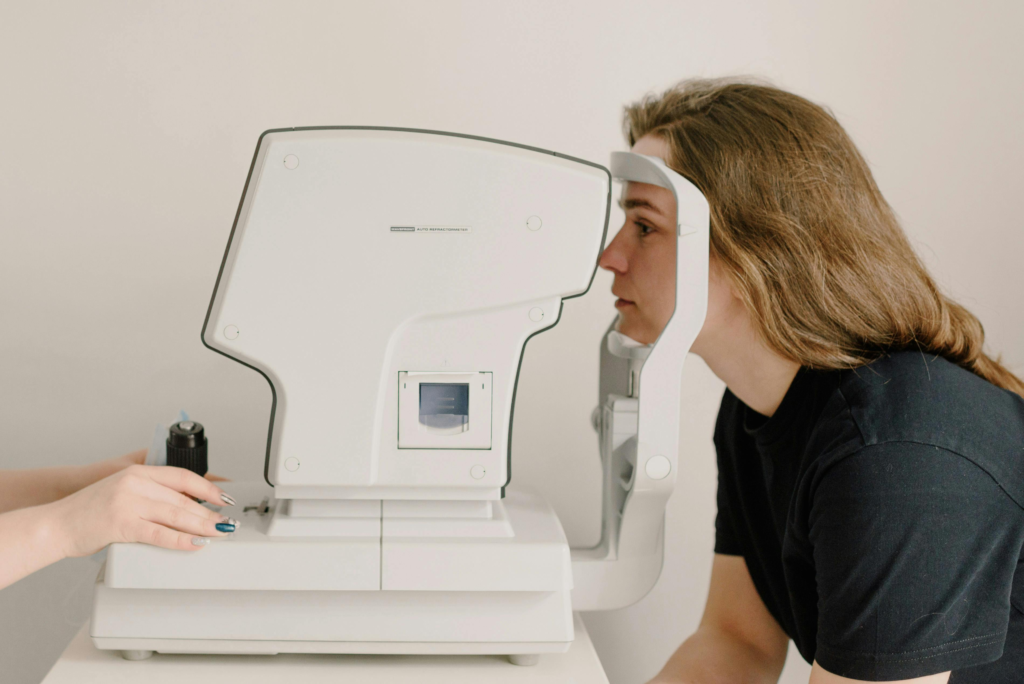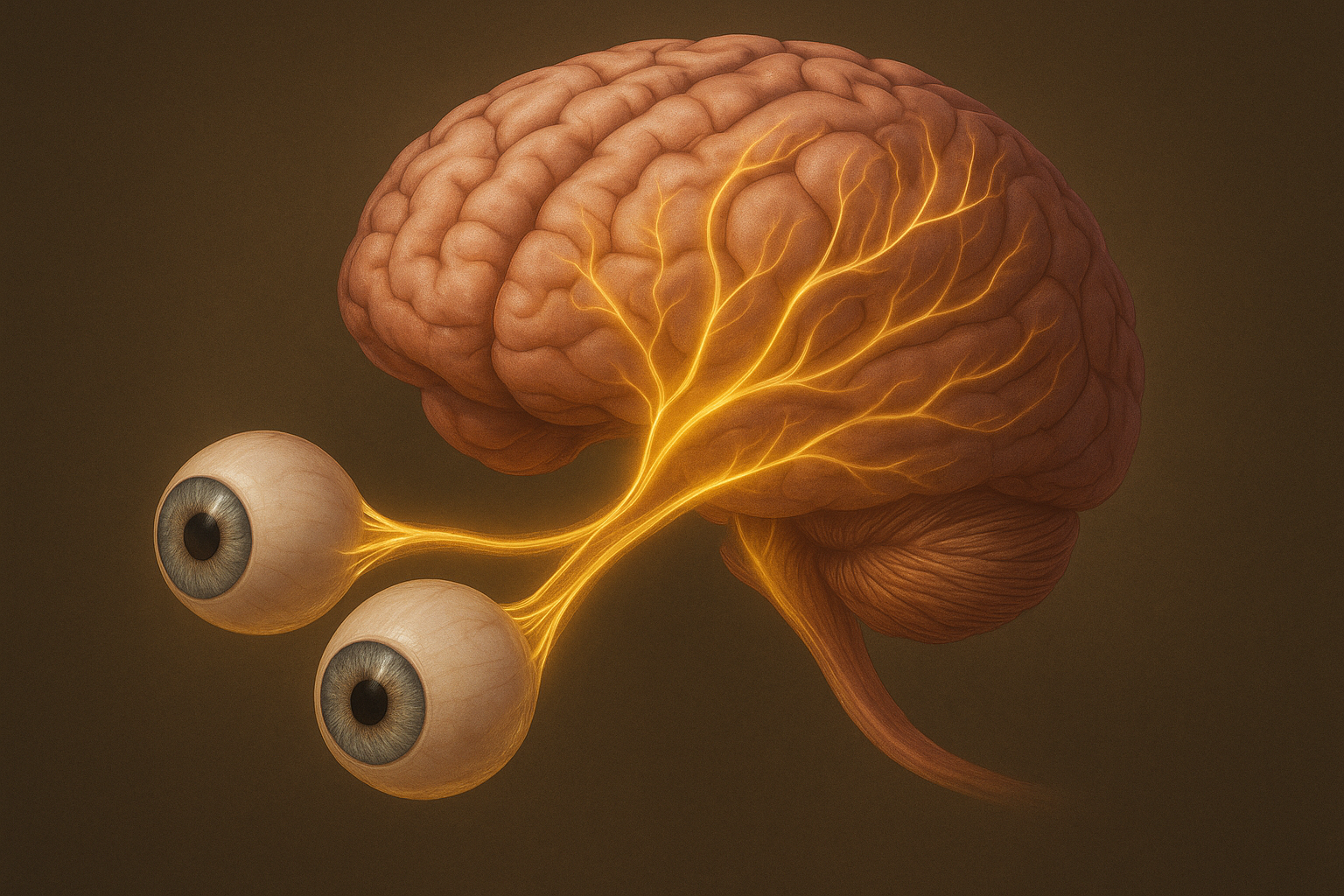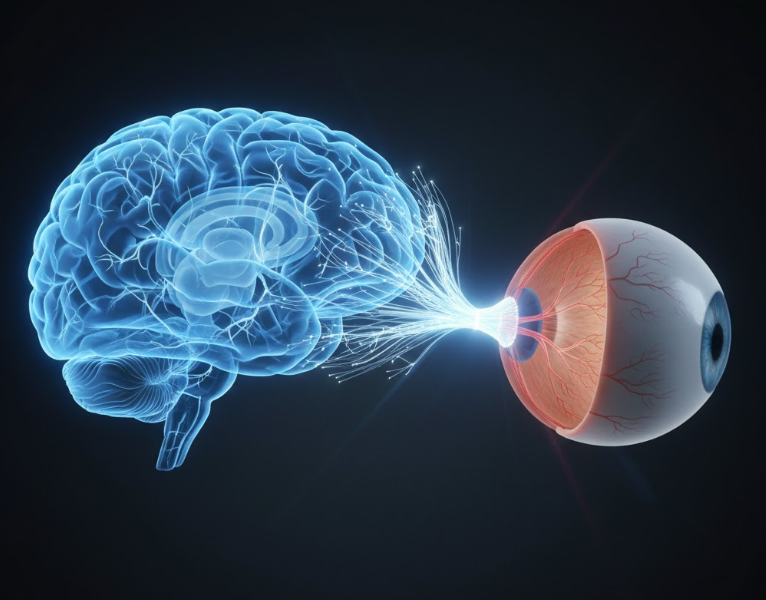🌍 Introduction: Your Eyes Are the Window to Your Brain
Uncover the crucial Eye Health and Brain Health link. Learn how your eyes act as a window to your neurological wellbeing, revealing early signs of Alzheimer’s, MS, and Parkinson’s disease.
The saying “the eyes are the window to the soul” may be poetic — but scientifically, the eyes are the window to the brain.
Every time you see something, your eyes and brain collaborate in real-time: the retina captures light, converts it into electrical signals, and sends those messages to the visual cortex through the optic nerve.
But what happens when this delicate communication breaks down?
Modern research shows that many neurological diseases first appear as eye symptoms — sometimes years before other signs. Alzheimer’s, Parkinson’s, Multiple Sclerosis (MS), and even stroke can manifest as blurred vision, color perception changes, or loss of contrast sensitivity.
This article explores the fascinating link between the eyes and the brain — and how protecting one can safeguard the other.

NOW Foods Lutein & Zeaxanthin
Supports macular health, blue light protection & visual performance.
- 25 mg Lutein + 5 mg Zeaxanthin
- Enhances visual function
- Helps with screen-related eye strain
🔬 1. The Eye-Brain Connection: A Biological Overview
The retina, located at the back of the eye, is technically an extension of the brain.
During early embryonic development, the retina forms from the same tissue as the brain — making it part of the central nervous system (CNS).
- The Optic Nerve is composed of over a million nerve fibers that directly link the eyes and brain.
- The Visual Cortex, located in the occipital lobe, interprets all visual signals — color, shape, movement, and depth.
- Blood Vessels in the Retina mirror those in the brain, meaning changes in one often indicate problems in the other.
This intimate link means that the state of your retina and optic nerve can reflect your neurological health.
🧩 2. How the Eyes Reflect Brain Health
Eye exams can reveal changes in blood vessels, nerve layers, and optic fibers that mimic processes happening in the brain.
In fact, ophthalmologists often say: “The retina is the only place in the body where we can directly see the brain’s blood vessels.”
For example:
- Retinal vessel narrowing may indicate early hypertension or stroke risk.
- Optic nerve swelling can suggest intracranial pressure or MS.
- Color vision loss might signal neurodegeneration in visual pathways.
⚠️ 3. Neurological Conditions First Detected Through Eye Exams
🧠 1. Alzheimer’s Disease
Patients often experience:
- Decreased contrast sensitivity
- Difficulty distinguishing colors
- Retinal thinning visible on OCT scans
Researchers found that changes in the retinal nerve fiber layer (RNFL) occur years before memory loss begins — making eye exams a potential tool for early detection.
🧩 2. Parkinson’s Disease
Eye-related symptoms include:
- Reduced blink rate
- Blurry or double vision
- Problems with eye movement control
Studies show Parkinson’s patients have dopamine deficiency not only in the brain but also in the retina, leading to slower visual processing.
⚡ 3. Multiple Sclerosis (MS)
MS causes inflammation and demyelination (loss of nerve insulation).
Eye-related effects include:
- Optic neuritis (painful vision loss in one eye)
- Color desaturation
- Visual field defects
OCT imaging helps monitor nerve fiber loss and disease progression.
🧬 4. Stroke and Vascular Brain Disorders
A sudden loss of vision in one eye can be a mini-stroke (TIA).
Eye exams can detect microaneurysms and vascular occlusions linked to brain blood flow issues.

👁️ 4. Early Vision Symptoms You Shouldn’t Ignore
Certain vision changes should always prompt neurological evaluation:
- Sudden blurred or double vision
- Loss of peripheral (side) vision
- Difficulty tracking moving objects
- Frequent visual “auras” or flashes
- Eye pain with movement
- Color fading or distorted contrast
These may indicate neurodegenerative or vascular conditions affecting the visual system.
🔍 5. How Modern Imaging Reveals Brain Disease Through the Eyes
The latest ophthalmic technologies allow doctors to see the brain through the eyes:
- Optical Coherence Tomography (OCT): Detects thinning of retinal nerve fibers.
- Fundus Photography: Captures blood vessel changes related to hypertension or dementia.
- Retinal Scanning AI: Machine learning algorithms can predict cognitive decline from retinal images.
In 2024, several studies confirmed that AI-based retinal imaging can predict Alzheimer’s up to 7 years before diagnosis.

🧘 6. Protecting Both Eye and Brain Health
The same habits that protect your eyes also protect your brain.
Both organs rely on blood flow, antioxidants, oxygen, and neural activity.
Key protective habits:
- Maintain healthy blood pressure and glucose
- Avoid smoking
- Exercise regularly (improves blood circulation)
- Get 7–8 hours of sleep
- Manage stress (reduces cortisol damage)
🥗 7. Nutrition and Lifestyle for a Strong Eye-Brain Axis
Nutrition is the cornerstone of neuro-visual health.
Deficiencies in omega-3s, lutein, vitamin B12, and antioxidants accelerate both cognitive and visual decline.
| Nutrient | Function | Food Source |
|---|---|---|
| Omega-3 DHA | Supports retinal and neuronal membranes | Salmon, flaxseed |
| Lutein & Zeaxanthin | Protect against oxidative stress | Kale, spinach, eggs |
| Vitamin B12 | Prevents nerve damage | Eggs, fish, fortified cereals |
| Vitamin E & C | Antioxidant protection | Citrus fruits, nuts |
| Curcumin | Neuroprotective anti-inflammatory | Turmeric, black pepper |
💤 8. The Role of Sleep, Stress, and Movement
Sleep deprivation reduces eye tear film quality and impairs neural visual processing.
Stress increases cortisol, which restricts blood flow to the optic nerve.
Movement (especially aerobic exercise) improves both retinal oxygenation and brain plasticity, helping protect memory and vision.
🔮 9. The Future of Neuro-Visual Diagnostics
The coming decade will redefine how we detect brain disorders — through the eyes.
AI and retinal scanning could soon become part of routine cognitive screenings, providing early warnings for dementia, stroke, and MS.
❓ 10. Frequently Asked Questions (FAQ)
Q1: Can eye exams detect Alzheimer’s disease?
Yes — retinal imaging can show nerve fiber thinning years before memory symptoms appear.
Q2: Does eye health affect brain performance?
Absolutely. The eyes send 80% of sensory input to the brain, so poor vision increases cognitive strain.
Q3: What’s the best way to protect both eyes and brain?
Follow a nutrient-rich diet, exercise regularly, manage stress, and schedule annual eye exams.
Q4: Is blurred vision always neurological?
Not always — but sudden, unexplained changes should be checked by an eye doctor or neurologist.
✅ Conclusion
Your eyes and brain are not separate systems — they are partners in perception.
Every flicker of light that reaches your retina travels a neural highway to your brain, shaping how you see, think, and react.
When vision deteriorates, it can be an early sign of deeper neurological imbalance. That’s why maintaining both ocular and cognitive health through nutrition, sleep, and regular checkups is essential.
Protecting your eyes means protecting your brain — and preserving the way you experience the world. 👁️🧠✨



